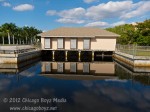The Canon PowerShot S95 is a higher-end small point-and-shoot type camera. Its electronics are supposed to be similar to those in the Canon PowerShot G12
. I haven’t used the G12 but my sense is that the main tradeoff between the two cameras is that the G12 is larger and easier to use with better controls and an optical viewfinder, while the S95 is very small. Indeed you can easily carry the S95 in a shirt pocket or trouser pocket (in the latter case I keep my camera in a Ziploc bag to minimize dust intrusion). For me the camera’s small size and reputedly high image quality were the reasons to get it. And it has turned out to be OK for my purposes despite some flaws. (The S95 is currently being supplanted by the similar S100
. Most of my comments should apply to both cameras.)
Details follow.
I’ve used the S95 extensively since I wrote this earlier post. I don’t use all of the modes or menus and haven’t made systematic tests. Mainly I use the camera in aperture priority mode with RAW file output. I’ve used the flash rarely and mainly as fill when making portraits in bright sunlight.
Here are my lists of pluses and minuses and recommendations:
PLUSES
-The camera is very small. It fits in a jersey pocket when I ride my bicycle (a post on this topic may follow) or, as noted above, easily in a shirt or trouser pocket. For me it’s a good choice as a carry-everywhere camera.
-For a camera of its type it is adequately fast in operation, though nowhere near as quick to use as a DSLR.
-Well designed controls. The S95 is much better than most other small cameras in this regard. There’s a mode wheel on top of the camera, a configurable function button on the back, and a rotating ring on the lens that is easily configured so that you can use it quickly to set aperture, ISO, exposure compensation, etc. The effect of having these physical controls is to make it unnecessary to click through menus to change important settings, which means the camera is very easy to use. The control setup is clear enough that you may not need to read the instructions, particularly if you have used a Canon digicam before. (Reviews of the newer Canon PowerShot S100 say that its control layout is improved over that of the S95.)
-Easy to shift to macro or manual focus mode (the latter useful especially for scenics).
-Easy to set manual exposure. This makes it relatively easy to do time exposures at night.
-Fast f/2.0 lens is a boon in less-than-bright environments.
-ISO usable to at least 800. The reviews that say 1600 is good are being optimistic. I was able to take adequate available-light pictures at a party at 2.0/800, which is great performance for a small digicam. (But note that the images are noisier than DSLR images even at low ISO settings.)
-Can generate RAW files.
-The automatic white balance works well though not perfectly. The option to use RAW files, which allow substantial color adjustment if you edit your images on your computer, is a big plus here.
MINUSES
-Quality control. I returned my first S95 because it had a big piece of lint in the lens or sensor that was visible in stopped-down sky photos. My second S95 seems OK.
-It’s still got a tiny imaging sensor. Photos look good for a point-and-shoot but, despite hype about this camera, are nowhere near as good as the output from even an older DSLR. But this may not matter for most users who are satisfied with point-and-shoot image quality or willing to trade image quality for very small camera size. There are now cameras in the G12 size range that have almost-DSLR-sized sensors and therefore superior image quality, but I don’t think you can do better at the size of the S95/100. (Perhaps this last point should be in the pluses category.)
-You will tend to foul the camera’s popup flash unit with your left hand. This problem has been discussed extensively in reviews of this camera. I don’t care much about this because I rarely use the flash, but even for me it’s an occasional annoyance and this issue may be worth considering if you use flash often.
-When holding the camera vertically in my right hand, my thumb tends to press the image review button which interferes with picture taking. I think the problem here is that the camera is so small that there is little room to grasp it without pressing buttons unintentionally.
-As compared to its successor, the S100, the S95 has a narrower zoom range, lower-quality video output and poorer low-light performance (here’s an intelligent review of the S100 that compares it to the S95 and finds among other advantages significantly better low-light performance).
-Unless I am missing something the S95 cannot make exposures longer than 15 seconds in manual mode. 30 seconds or more would have been better.
RECOMMENDATIONS
If you want a high-quality tiny camera and don’t care about price get the S100. It has a wider zoom range (24mm vs. 28mm on the short end, which is significant), 1080p vs. 720p video, and from what I have read significantly better performance in low light than the S95.
If you like the S95/100 and care about price wait for the S95 to go on sale. I wouldn’t buy it at the current going rate of around $330, because for another hundred bucks you can get the superior S100. But at $230 or so the S95 is a good deal.
Or do as Dan from Madison did and order the Canon PowerShot ELPH 300 HS. In that case you pay less and I suspect get a slightly smaller sensor and less manual control, but you also get 1080p video, a flash that doesn’t pop up into your left hand, and no RAW capability but probably similar picture quality in good light or flash as with the pricier S models. I don’t think you can go wrong with any of the mid-to-high end Canon digicams.
If you do buy, please consider doing so by clicking the Amazon or B&H links on this site so that Chicagoboyz can earn a few shekels. Thanks.
Canon S100 at Amazon / at B&H
Canon S95 at Amazon / at B&H
Canon 300HS at Amazon / at B&H
Canon G12 at Amazon / at B&H
(Note that the S95 is no longer available from B&H. This may mean that the low S95 prices of last month will not return as inventory dries up.)
SAMPLE IMAGES
(These have all been edited in various ways. Click each image twice to see it at full size.)









I will review my new camera when it arrives and put it up here.
I thought about going for the S95, but I hesitated, because I really want the 24 mm wide angle in the S100. It is CES time and the OEMs are releasing new models.
Canon has released the G1X, which is physically like the G series, but has a much bigger sensor. The G12 and the S95/100 had what is called a 1/1.7″ sensor, which is 7.44 x 5.58 mm (43.3 mm^2). The new G1X uses a 18.7 x 14 mm sensor. At 262 mm^2, it is actually larger than the 4/3rds sensors used in interchangeable lens cameras by Olympus and Panasonic. But it is not as big as the APS-C sensor 23.6 mm x 15.6 mm 368 mm^2, used on many consumer SLRs.
Bigger sensors produce better pictures, but they are more expensive, require larger cameras, and larger lenses. The G1X is 534 g and 117 x 81 x 65 mm. And they cost more money, Canon wants $800 for the G1X.
The S100 with the smaller sensor is 198 g and 99 x 60 x 28 mm and is a mere $430.
My A1000 (out of production) has the tiny 6.16 x 4.62 mm 1/2.3″ sensor (28.5 mm^2) 155 g
Dimensions 96 x 63 x 31 mm and cost me $130 when new. 1/2.3″ is Canon’s standard sensor size for small cameras. Some other OEMs, including Nikon, are still using 1/2.5″ sensors, 5.76 x 4.29 mm 24.7 mm^2, for their cheapest cameras.
The big advantage of DSLRs is that most of them use the very big APS-C sensor. But they weigh more and cost more than most smaller cameras, although the G1X is not cheaper than the lesser DSLRs. A few such as the Nikon D3 have full frame (36 x 24 mm sensors) but they cost a couple of thousand dollars at least.
Information sources:
http://en.wikipedia.org/wiki/Sensor_sizes
http://www.dpreview.com/ Lots of tools for comparing cameras in every different aspect.
Thanks, Robert.
The Canon G1 X looks very good. It should have very high image quality, probably quieter operation than a DSLR, smaller, and because the lens is not interchangeable there shouldn’t be any problems with dust on the sensor.